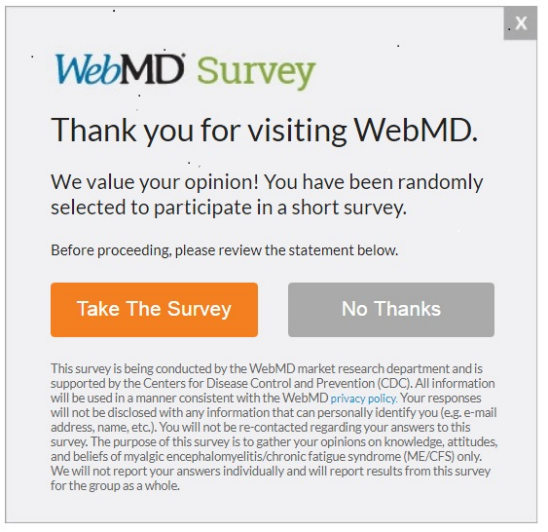Supporting Statement B: Statistical Methods
2_SSB_HEHP_MECFS_KAB_Pilot_20201123.docx
CDC/ATSDR Formative Research and Tool Development
Supporting Statement B: Statistical Methods
OMB: 0920-1154
Health Education and Health Promotion in Myalgic Encephalomyelitis/Chronic Fatigue Syndrome (ME/CFS): Knowledge, Attitudes and Beliefs in the U.S. General Public
Generic Information Collection Request under OMB No. 0920-1154
November 23, 2020
Supporting Statement B
Contact:
Thomas J. “Chip” Daymude
National Center for Emerging and Zoonotic Infectious Diseases
Centers for Disease Control and Prevention
1600 Clifton Road, NE
Atlanta, Georgia 30333
Phone: (470) 553-3567
Email: [email protected]
Table of Contents
1. Respondent Universe and Sampling Methods 2
2. Procedures for the Collection of Information 2
3. Methods to maximize Response Rates and Deal with No Response 3
4. Tests of Procedures or Methods to be Undertaken 3
5. Individuals Consulted on Statistical Aspects and Individuals Collecting and/or Analyzing Data 3
Descriptive statistics will be performed and percentages will be calculated for perception and KAB. For examining KAB differences between demographic subgroups such as age group, sex, race/ethnicity, and socio-economic status, we will perform proportions tests and report 95% confidence levels.
Respondent Universe and Sampling Methods
WebMD reached 79.0 million adults aged 18 and older in September 2019, representing 35% of the total U.S. adult online population and demonstrating broad representation of the online population. Since the objective is to assess knowledge, attitudes, and beliefs about ME/CFS among the general population, the total sample universe is N=3,500 adults 18 and older who are living in the United States. No other screening criteria are proposed.
We will collect additional demographic information to facilitate analysis by subgroups. Subgroups of analytical interest include race/ethnicity, age, sex, and socioeconomic status. Based on previous surveys, WebMD estimates for a natural capture sample of N=3,500 are shown in Table 1. This fallout shows that a planned comparison of subgroups has the distribution of 77% for non-Hispanic Whites, 9% non-Hispanic Blacks, and 7% Hispanic.
Table 1.
Subgroup Race/Ethnicity |
N=3500 |
WebMD Percent from past Natural Sample Recruitment |
Non-Hispanic White |
2679 |
77% |
Non-Hispanic Black |
298 |
9% |
Hispanic |
251 |
7% |
Other |
372 |
8% |
WebMD has determined that screening out those who were under 18 and not living in the U.S. is about 5% and this rate has been applied to determine the additional number of persons needed for recruitment bringing it to 3,675. If more recruitment is needed to fill the cells for recruitment of subgroup comparison on race/ethnicity, an additional 125 respondents will be recruited bringing the screening recruitment goal to 3800. However, if we succeed in race/ethnicity subgroup recruitment goals with the total sample at 3500, then we will cease recruitment because the goal has been met.
WebMD technical staff will program the survey questions and logic into WebMD’s web-based survey system that meets section 508 compliance requirements for accessibility.
An interstitial (pop-up) invitation to participate in the survey will be presented to randomly selected visitors as they navigate throughout the webmd.com website (see Figure 1 or Attachment 1 for the survey invitation). The survey invitation includes the WebMD privacy statement and CDC sponsorship disclosure. Upon accepting the invitation to participate, a screener “pop-up” box appears with 7 questions (see Attachment 2) that assess the inclusion criteria.
If eligibility criteria are met, a full survey window will be presented to the respondent (see Attachment 3). The survey also contains a statement about estimated time burden to complete the survey.
If the respondent does not meet the eligibility criteria, a message appears that thanks the person for their time and states the input is no longer needed.

Participants will be recruited into the study until the sample and subgroup goals are met. WebMD will continue to rotate the pop-up invitation as people come to the website until the total respondents and race/ethnicity subgroup numbers are recruited. If recruitment succeeds in meeting the sample size and race/ethnicity subgroup at 3,500 or before 3,800, then we will stop recruitment.
No pre-tests are planned as the WebMD methodology has been tested previously. The data collection instruments for ME/CFS KAB assessment have been used in previous ME/CFS studies or other illnesses.
CDC
Jin-Mann S. Lin, PhD
Mathematical Statistician
Chronic Viral Diseases Branch
Division of High Consequence Pathogens and Pathology
National Center for Emerging and Zoonotic Infectious Diseases
Centers for Disease Control and Prevention
1600 Clifton Rd, NE MS H24-12
Atlanta, Georgia 30329
Phone: 404-639-1646
Contractor - WebMD
Christina Louie
Executive Director, Market Research
(212) 417-9982 |
395 Hudson Street
New York, New York, 10014
Stanislav Zakharkin, Ph.D.
Statistician
(212) 417-9982
395 Hudson Street
New York, New York, 10014
| File Type | application/vnd.openxmlformats-officedocument.wordprocessingml.document |
| Author | Samuel, Lee (CDC/OID/NCEZID);[email protected] |
| File Modified | 0000-00-00 |
| File Created | 2021-01-13 |
© 2026 OMB.report | Privacy Policy